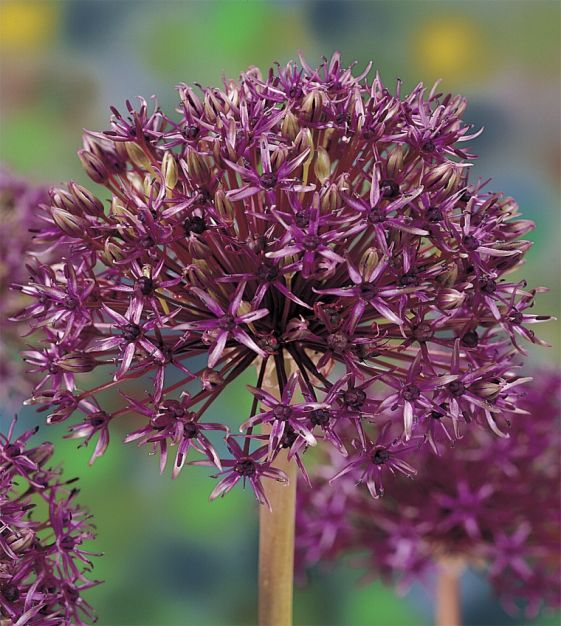-
- 20%-Off Website Specials
- New for 2024!
- Tulips
- Narcissi
- Allium
- Anemone blanda
- Brodiaea
- Camassia
- Chionodoxa
- Corydalis
- Crocus
- Eranthis
- Eremurus
- Erythronium
- Fritillaria
- Galanthus
- Geranium
- Gladiolus
- Hyacinths
- Hyacinthoides
- Ipheion uniflorum
- Dutch Iris
- Rock Garden Iris
- Ixiolirion
- Leucojum Aestivum
- Muscari
- Ornithogalum
- Oxalis
- Puschkinia
- Scilla
- Lilies
- Peonies
- Tender Bulbs
- Anemone Giants
- Tecolote Ranunculus
- Freesias
- Paperwhites
- Amaryllis
Allium Firmament
Rabbit-, rodent- and deer-resistant Firmament has composite 4"- to 5"-wide globes with somewhat flat bottoms. Each sultry flower is comprised of metallic, merlot-purple florets embellished with shimmering silver anthers. It gets its metallic luster from its parent, A. christophii, and its dark color and height from its parent, A. atropurpureum. Bulb size: 8 cm/up. May/June. HZ: 5-8. Height: 24" to 32".
We are very sorry, but due to state agricultural restrictions, we are not permitted to ship Allium bulbs to Idaho, or to the following five counties in the State of Washington: Adams, Benton, Franklin, Grant and Klickitat.
Allium are The Art & Soul of Spring and Summer.
Allium Horticultural Tips
Allium are The Art & Soul of Spring and Summer.
Allium Horticultural Tips
- Information
Allium
Latin for garlic, the Flowering Onions are available in diverse heights and sizes, are rabbit-, rodent- and deer-resistant, and are seldom affected by disease. Adored by bees, butterflies and pollinators, Allium extend the spring flowering season with bold, dramatic color and statuesque garden architecture. They are also valuable cut and dried flowers.
Allium require full sunlight although there are several varieties that can also thrive in partial sunlight: A. cowanii, oreophilum and siculum bulgaricum. Allium require rich, well-draining and neutral pH soil and benefit from a summer dry period. A. unifolium can handle soil with a bit more moisture. All Allium must be planted outdoors in the fall after the soil has cooled down to around 55°F (normally after two weeks of night time temperatures hovering around 40°F). While most Allium are not recommended for forcing over the winter, there are several varieties that are known to be good forcers: A. cowanii, karataviense and unifolium. Please note that flower size is presented as the width, or diameter, from left to right.
Plant the larger Allium bulbs 6" to 8" deep and 8" to 10" apart. Plant the smaller Allium bulbs 4" deep and 3" to 4" apart. Top size bulbs. Bloom time: May through August depending on the variety. Height: variable depending on the variety. Variable horticultural zones ranging from 3-10 depending on the variety.
We’re very sorry, but due to state agricultural restrictions, we are not permitted to ship Allium bulbs to Idaho, or the following five counties in the State of Washington: Adams, Benton, Franklin, Grant and Klickitat.
Allium are The Art & Soul of Spring and Summer.
Allium Horticultural Tips
Latin for garlic, the Flowering Onions are available in diverse heights and sizes, are rabbit-, rodent- and deer-resistant, and are seldom affected by disease. Adored by bees, butterflies and pollinators, Allium extend the spring flowering season with bold, dramatic color and statuesque garden architecture. They are also valuable cut and dried flowers.
Allium require full sunlight although there are several varieties that can also thrive in partial sunlight: A. cowanii, oreophilum and siculum bulgaricum. Allium require rich, well-draining and neutral pH soil and benefit from a summer dry period. A. unifolium can handle soil with a bit more moisture. All Allium must be planted outdoors in the fall after the soil has cooled down to around 55°F (normally after two weeks of night time temperatures hovering around 40°F). While most Allium are not recommended for forcing over the winter, there are several varieties that are known to be good forcers: A. cowanii, karataviense and unifolium. Please note that flower size is presented as the width, or diameter, from left to right.
Plant the larger Allium bulbs 6" to 8" deep and 8" to 10" apart. Plant the smaller Allium bulbs 4" deep and 3" to 4" apart. Top size bulbs. Bloom time: May through August depending on the variety. Height: variable depending on the variety. Variable horticultural zones ranging from 3-10 depending on the variety.
We’re very sorry, but due to state agricultural restrictions, we are not permitted to ship Allium bulbs to Idaho, or the following five counties in the State of Washington: Adams, Benton, Franklin, Grant and Klickitat.
Allium are The Art & Soul of Spring and Summer.
Allium Horticultural Tips
Allium
Latin for garlic, the Flowering Onions are available in diverse heights and sizes, are rabbit-, rodent- and deer-resistant, and are seldom affected by disease. Adored by bees, butterflies and pollinators, Allium extend the spring flowering season with bold, dramatic color and statuesque garden architecture. They are also valuable cut and dried flowers.
Allium require full sunlight although there are several varieties that can also thrive in partial sunlight: A. cowanii, oreophilum and siculum bulgaricum. Allium require rich, well-draining and neutral pH soil and benefit from a summer dry period. A. unifolium can handle soil with a bit more moisture. All Allium must be planted outdoors in the fall after the soil has cooled down to around 55°F (normally after two weeks of night time temperatures hovering around 40°F). While most Allium are not recommended for forcing over the winter, there are several varieties that are known to be good forcers: A. cowanii, karataviense and unifolium. Please note that flower size is presented as the width, or diameter, from left to right.
Plant the larger Allium bulbs 6" to 8" deep and 8" to 10" apart. Plant the smaller Allium bulbs 4" deep and 3" to 4" apart. Top size bulbs. Bloom time: May through August depending on the variety. Height: variable depending on the variety. Variable horticultural zones ranging from 3-10 depending on the variety.
We’re very sorry, but due to state agricultural restrictions, we are not permitted to ship Allium bulbs to Idaho, or the following five counties in the State of Washington: Adams, Benton, Franklin, Grant and Klickitat.
Allium are The Art & Soul of Spring and Summer.
Allium Horticultural Tips
Latin for garlic, the Flowering Onions are available in diverse heights and sizes, are rabbit-, rodent- and deer-resistant, and are seldom affected by disease. Adored by bees, butterflies and pollinators, Allium extend the spring flowering season with bold, dramatic color and statuesque garden architecture. They are also valuable cut and dried flowers.
Allium require full sunlight although there are several varieties that can also thrive in partial sunlight: A. cowanii, oreophilum and siculum bulgaricum. Allium require rich, well-draining and neutral pH soil and benefit from a summer dry period. A. unifolium can handle soil with a bit more moisture. All Allium must be planted outdoors in the fall after the soil has cooled down to around 55°F (normally after two weeks of night time temperatures hovering around 40°F). While most Allium are not recommended for forcing over the winter, there are several varieties that are known to be good forcers: A. cowanii, karataviense and unifolium. Please note that flower size is presented as the width, or diameter, from left to right.
Plant the larger Allium bulbs 6" to 8" deep and 8" to 10" apart. Plant the smaller Allium bulbs 4" deep and 3" to 4" apart. Top size bulbs. Bloom time: May through August depending on the variety. Height: variable depending on the variety. Variable horticultural zones ranging from 3-10 depending on the variety.
We’re very sorry, but due to state agricultural restrictions, we are not permitted to ship Allium bulbs to Idaho, or the following five counties in the State of Washington: Adams, Benton, Franklin, Grant and Klickitat.
Allium are The Art & Soul of Spring and Summer.
Allium Horticultural Tips





